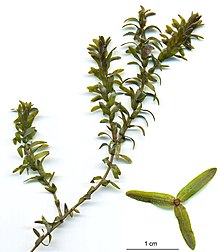Elodea canadensis
| Elodea canadensis | |
|---|---|

| |
| Scientific classification | |
| Kingdom: | Plantae |
| Clade: | Tracheophytes |
| Clade: | Angiosperms |
| Clade: | Monocots |
| Order: | Alismatales |
| Family: | Hydrocharitaceae |
| Genus: | Elodea |
| Species: | E. canadensis
|
| Binomial name | |
| Elodea canadensis | |
| Synonyms | |
| |
Elodea canadensis (American waterweed or Canadian waterweed or pondweed) is a
Distribution
The native range of the species lies within North America, but it has been introduced in many parts of the world either intentionally or not. Europe has been particularly affected with the first record dating back as far as 1836.[5] Since then, the species' presence has been confirmed in all continental European countries.[6]
Records of the species' presence in Ireland include: County Galway, found at several sites along the Eglinton Canal, County Galway,[7] County Down. and from the Lagan Canal near Lisburn, Northern Ireland.[8]
Description
Young plants initially start with a seedling stem with roots growing in mud at the bottom of the water; further adventitious roots are produced at intervals along the stem, which may hang free in the water or anchor into the bottom. It grows indefinitely at the stem tips, and single specimens may reach lengths of 3 m or more.
The
It is
It grows rapidly in favorable conditions and can choke shallow ponds, canals, and the margins of some slow-flowing rivers. It requires summer water temperatures of 10–25 °C and moderate-to-bright light levels.[12]
It is closely related to Elodea nuttallii, which generally has narrower leaves under 2 mm broad. It is usually fairly easy to distinguish from its relatives, like the Brazilian Egeria densa and Hydrilla verticillata. These all have leaves in whorls around the stem; however, Elodea usually has three leaves per whorl, whereas Egeria and Hydrilla usually have four or more. Egeria densa is also a larger, bushier plant, with longer leaves.[13]
Cultivation and uses
It is frequently used as an aquarium plant. Propagation is by cuttings.[14]
It is an invasive species in Europe, Asia, Africa, and Oceania. It was introduced into County Down, Ireland in about 1836, and appeared in Great Britain in 1841, spreading through both countries in ponds, ditches and streams, which were often choked with its rank growth.[15][12][13][16]
Other common names for this plant include Anacharis (an older name for the genus Elodea), water thyme, common elodea, and ditch moss.[citation needed]
Gallery
-
Ditch with a dense colony of flowering plants
-
Illustration showing leaf and flower detail
-
Close up image of the leaf tip
References
- ^ a b Flora of North America: Elodea canadensis
- ^ a b Plants of British Columbia: Elodea canadensis Archived 2020-08-09 at the Wayback Machine
- ^ a b Jepson Flora: Elodea canadensis
- ISBN 0-85389-446-9(HB)
- ^ Simpson, D.A. (1984). "A short history on the introduction and spread of Elodea Michx. in the British Isles". Watsonia. 15: 1–9.
- ISSN 1854-9829. Archived from the originalon 2017-12-03. Retrieved 2017-08-02.
- ^ Pybus, C. and O'Halloran, P. 2009. Distribution of some submerged aquatic macrophytes in the Eglinton Canal, Galway; Ir. Nat J. 30: 51 -53
- ^ Hackney, P. 1992
- ISBN 978-0-7232-5175-0.
- ^ Bailey, Liberty Hyde, ed. (1935). Cyclopedia of Horticulture. New York: MacMillan and Co. p. Vol. 1 p. 1110.
- ^ Wilie, Robert B. (January 1904). "The Morphology of Elodea canadensis". Botanical Gazette. 37 (1): 4.
- ^ ISBN 0-333-47494-5.
- ^ a b Native Freshwater Plants: American Waterweed Archived 2005-06-13 at the Wayback Machine
- ISBN 0-7641-5521-0.
- ^ One or more of the preceding sentences incorporates text from a publication now in the public domain: Chisholm, Hugh, ed. (1911). "Water-thyme". Encyclopædia Britannica. Vol. 1 (11th ed.). Cambridge University Press. p. 410.
- ^ Flora of NW Europe: Elodea canadensis Archived 2008-03-11 at the Wayback Machine



